Installing a home fuel cell heating system can greatly reduce your energy costs and carbon footprint. You'll need to understand fuel cell technology, assess your home's energy needs, and choose the right type of fuel cell. Proper sizing, tool preparation, and safety precautions are essential. You'll connect the system to your existing power and heating infrastructure, ensuring proper ventilation and fuel storage. Electrical integration and system testing are key steps in the process. Regular maintenance will keep your system running efficiently. With careful planning and execution, you can harness this innovative technology for your home's energy needs. Discover how to tackle this rewarding DIY project step-by-step.
Understanding Fuel Cell Technology
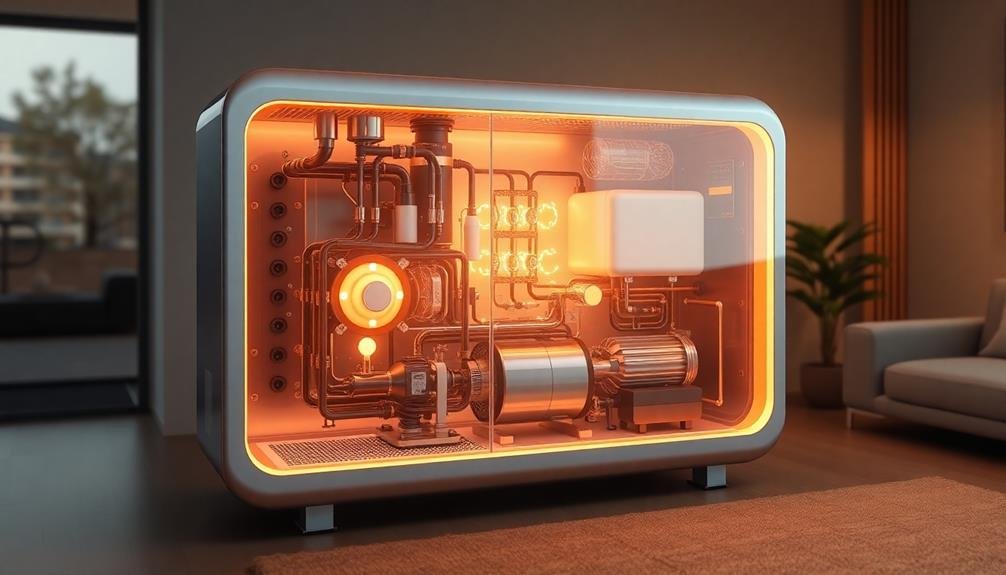
Fuel cells are electrochemical devices that convert chemical energy into electricity. They work by combining hydrogen and oxygen to produce electricity, heat, and water. Unlike batteries, fuel cells don't run down or require recharging; they'll continue to produce electricity as long as fuel is supplied.
You'll find several types of fuel cells, but for home heating systems, you're most likely to encounter proton exchange membrane (PEM) fuel cells or solid oxide fuel cells (SOFCs). PEM fuel cells operate at lower temperatures and are more compact, making them suitable for residential use.
SOFCs, on the other hand, can run at higher temperatures and are more efficient, but they're typically larger and take longer to start up.
In a home fuel cell system, you'll need a fuel processor to extract hydrogen from natural gas or propane. The fuel cell then combines this hydrogen with oxygen from the air to generate electricity.
The heat produced as a byproduct can be used for space heating and hot water, making these systems highly efficient. You'll also need an inverter to convert the DC electricity produced by the fuel cell into AC power for your home.
Benefits of Home Fuel Cells
Now that you understand how fuel cells work, let's explore why you might want to install one in your home. Fuel cells offer several advantages over traditional heating systems.
First, they're highly efficient, converting up to 90% of fuel energy into usable heat and electricity. This efficiency can greatly reduce your energy bills and carbon footprint.
You'll also enjoy increased energy independence. Fuel cells can operate off-grid, providing reliable power during outages. They're quiet, producing minimal noise compared to generators or furnaces.
With fewer moving parts, fuel cells require less maintenance and have a longer lifespan than conventional heating systems.
Another benefit is their versatility. Fuel cells can provide both heat and electricity, potentially eliminating the need for separate systems. They can run on various fuels, including natural gas, propane, or hydrogen, giving you flexibility in energy sources.
Environmentally, fuel cells produce fewer emissions than combustion-based systems. They generate clean water as a byproduct, which you can collect for other uses.
Assessing Your Home's Energy Needs
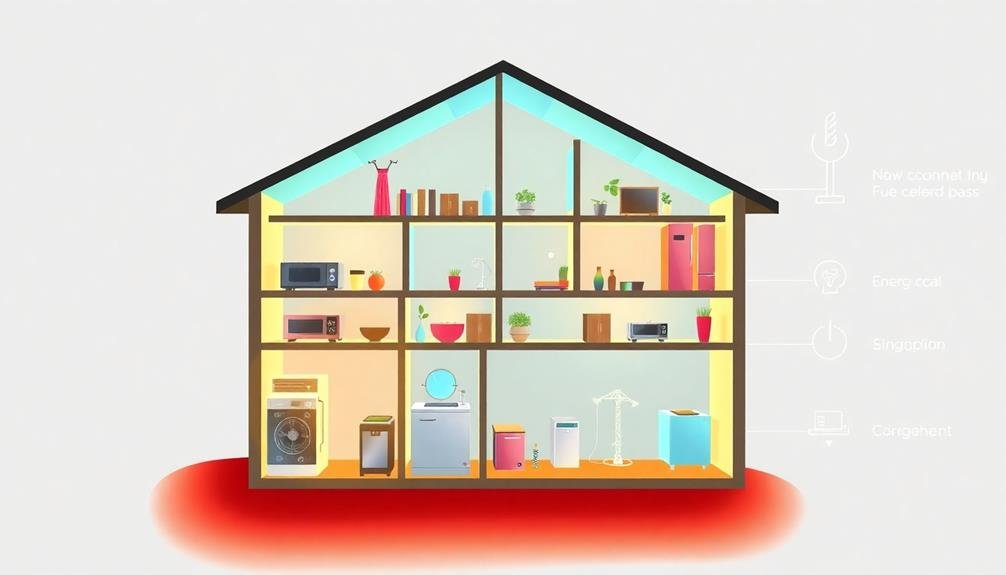
Before diving into fuel cell installation, it's crucial to accurately assess your home's energy needs. Start by reviewing your utility bills from the past year to determine your average energy consumption. Pay attention to seasonal variations, as your heating requirements will likely differ between winter and summer months.
Next, conduct an energy audit of your home. Identify areas where you're losing heat, such as poorly insulated walls, windows, or doors. Consider upgrading your insulation or sealing air leaks to reduce your overall energy demands.
Evaluate your current heating system's capacity and efficiency. Compare this to your home's square footage and the climate in your area. This will help you determine the appropriate size for your fuel cell system.
Don't forget to account for future energy needs. Are you planning any home additions or expecting changes in your household size? Factor these into your calculations.
Lastly, consider your budget and long-term energy goals. While fuel cells can provide significant savings over time, they require a substantial upfront investment. Weigh the costs against your expected energy savings to determine if a fuel cell system is right for you.
Choosing the Right Fuel Cell
When choosing a fuel cell for your home heating system, you'll need to take into account the different types available.
Proton exchange membrane (PEM) and solid oxide fuel cells (SOFC) are two common options for residential use.
You'll also want to verify the fuel cell's output capacity matches your home's energy requirements, which you calculated in the previous step.
Types of Fuel Cells
Fuel cells come in several varieties, each with unique characteristics suited for different home heating applications. The most common types you'll encounter for residential use are Proton Exchange Membrane (PEM), Solid Oxide Fuel Cells (SOFC), and Phosphoric Acid Fuel Cells (PAFC).
PEM fuel cells operate at lower temperatures (around 80°C) and are ideal for smaller homes. They're efficient, compact, and have a quick start-up time. However, they require pure hydrogen as fuel, which can be more expensive.
SOFCs work at high temperatures (600-1000°C) and can use various fuels, including natural gas and biogas. They're highly efficient and produce high-quality waste heat, making them excellent for combined heat and power systems. The downside is their longer start-up time and higher initial cost.
PAFCs operate at medium temperatures (150-200°C) and are known for their reliability and durability. They can use impure hydrogen and tolerate carbon monoxide, making them flexible in fuel choice. However, they're less efficient than PEM cells and have a slower start-up time.
When selecting a fuel cell type, consider your home's size, energy needs, available fuel sources, and budget to make the best choice.
Sizing for Your Home
Picking out the right size fuel cell for your home boils down to understanding your energy needs.
Begin by calculating your average monthly electricity consumption in kilowatt-hours (kWh). You'll find this information on your utility bills. Next, determine your peak power demand, which is the maximum amount of electricity your home uses at any given time.
Consider your heating requirements as well. If you're planning to use the fuel cell for both electricity and heat, factor in your home's square footage and insulation quality. Climate plays a significant role too – colder regions will require more heating capacity.
Most residential fuel cells range from 1 to 5 kW in output. A 1 kW system might suffice for a small, energy-efficient home, while larger houses or those with higher energy demands may need a 3-5 kW system.
Don't forget to account for future needs – if you're planning to add electric vehicles or expand your home, you'll want extra capacity.
It's essential to consult with a professional who can perform a detailed load analysis and help you choose the most appropriate fuel cell size for your specific situation.
Required Tools and Materials
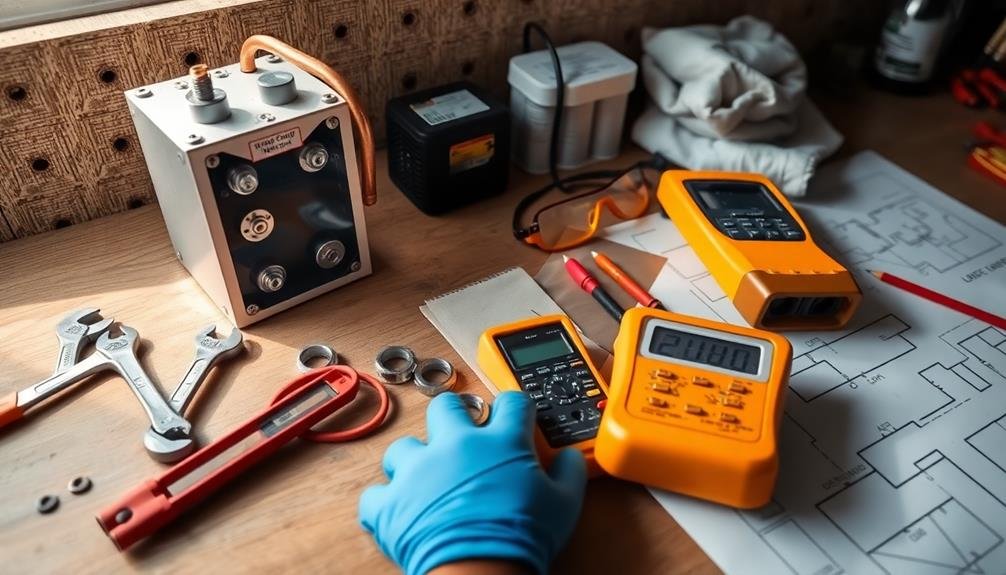
Before starting your DIY fuel cell heating system project, you'll need to gather the necessary tools and materials. Essential tools include a pipe cutter, adjustable wrench, screwdrivers, voltage meter, and wire strippers. You'll also need safety equipment like goggles, gloves, and a fire extinguisher.
For materials, you'll require the fuel cell unit itself, which typically comes with a reformer and power inverter. You'll need copper piping for water connections, PVC piping for venting, and electrical wiring. Don't forget to get heat-resistant silicone sealant, pipe insulation, and mounting brackets.
Specific components vary based on your chosen system, but generally include a natural gas or propane connection, water pump, heat exchanger, and backup battery. You'll also need a smart thermostat compatible with fuel cell systems.
Ensure you have all necessary permits and familiarize yourself with local building codes. It's vital to have a professional electrician and plumber inspect your work before activation.
Safety Precautions and Regulations
Safety should be your top priority when installing a home fuel cell heating system. Always wear protective gear, including safety glasses, gloves, and a respirator. Guarantee proper ventilation in your work area to prevent the accumulation of harmful gases.
Before starting, familiarize yourself with local building codes and regulations regarding fuel cell installations. You'll likely need permits and inspections, so contact your local authorities. Follow manufacturer guidelines strictly and don't attempt modifications without expert advice.
Be aware of electrical hazards. Fuel cells generate high voltages, so guarantee proper insulation and grounding. Use a voltage tester to verify power is off before working on any electrical components. Keep water sources away from electrical connections.
Handle fuel sources carefully. Natural gas and hydrogen are highly flammable. Check for leaks regularly using a gas detector. Install carbon monoxide and smoke detectors near the fuel cell system.
Never operate the system if you suspect a malfunction. Have emergency shutdown procedures in place and know how to use them. Keep a fire extinguisher nearby and guarantee all household members know its location.
Lastly, consider professional installation if you're unsure about any aspect of the process. Your safety is worth the investment.
Preparing Your Installation Space
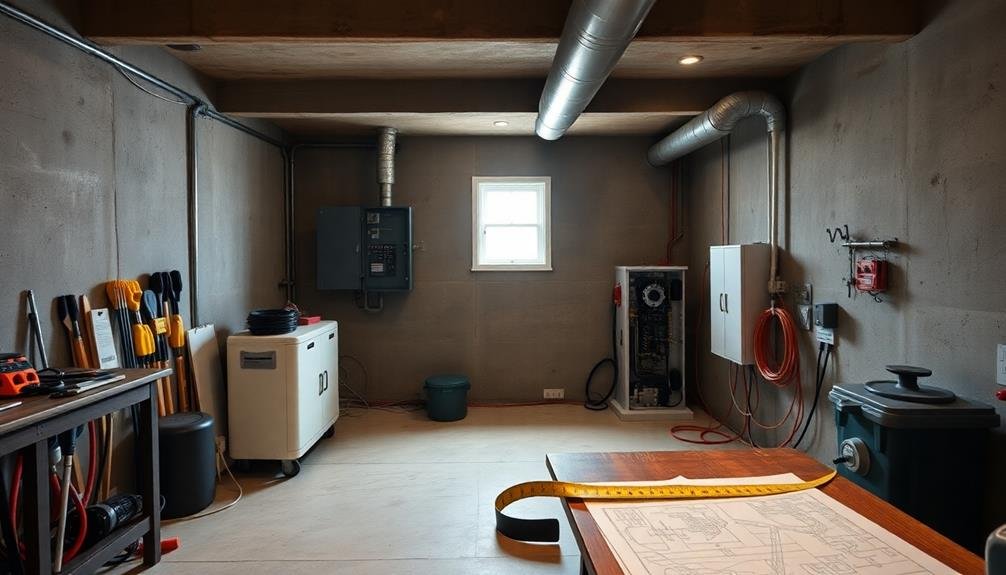
When preparing your installation space for a home fuel cell heating system, you'll need to take into account two essential factors: ventilation and power source proximity.
Make certain your chosen area has adequate airflow to prevent the buildup of potentially harmful gases and maintain peak system performance.
Position your fuel cell near your home's electrical panel to minimize wiring complexity and maximize efficiency.
Ventilation and Air Flow
Proper ventilation and air flow are essential for any fuel cell heating system installation. You'll need to verify your chosen location has adequate airflow to support combustion and remove exhaust gases safely. Start by measuring the space and calculating the required air exchange rate based on your fuel cell's specifications.
Install intake and exhaust vents according to local building codes and manufacturer recommendations. These should be placed on opposite sides of the room to promote cross-ventilation. Use corrosion-resistant materials for vent pipes, as fuel cell exhaust can be acidic. Don't forget to include carbon monoxide detectors near the installation area.
Consider the impact of nearby obstacles on air circulation. Remove any clutter that could impede airflow or pose a fire hazard. If you're installing the fuel cell in a confined space, you may need to add mechanical ventilation systems like exhaust fans or blowers.
Seal any gaps or cracks in walls and floors to prevent exhaust gases from entering living spaces. This step is vital for maintaining indoor air quality and safety.
Power Source Proximity
Proximity to a suitable power source is essential when preparing your installation space for a home fuel cell heating system. You'll need to guarantee that your chosen location has easy access to both electrical and gas connections. The fuel cell unit requires a steady supply of natural gas or propane, as well as a connection to your home's electrical system for power distribution.
When selecting the installation site, consider the following factors:
| Factor | Importance | Considerations |
|---|---|---|
| Electrical | High | 240V outlet, circuit capacity |
| Gas | High | Natural gas or propane line |
| Ventilation | Medium | Proper airflow for exhaust |
Measure the distance between your proposed installation site and the nearest power sources. You'll want to minimize the length of electrical and gas lines to reduce potential energy loss and installation costs. If necessary, consult with a licensed electrician or plumber to determine if your existing infrastructure can support the fuel cell system's requirements.
Remember that fuel cells generate both heat and electricity, so you'll need to plan for integrating the system with your home's existing heating and electrical systems. Guarantee that there's enough space for any additional components, such as inverters or heat exchangers, that may be required for seamless integration.
Connecting to Existing Systems
Integration is key when connecting your new fuel cell heating system to your home's existing infrastructure. You'll need to interface with your current heating, electrical, and plumbing systems.
Start by identifying the main connection points: your electrical panel, hot water tank, and existing ductwork or radiators.
For electrical integration, you'll install a transfer switch near your main panel. This allows your fuel cell to seamlessly provide power when needed. Connect the fuel cell's output to this switch, ensuring proper voltage matching and circuit protection.
Next, tackle the heating integration. You'll need to connect the fuel cell's heat exchanger to your existing distribution system. For forced air systems, this means tying into your ductwork. For radiant systems, you'll connect to your boiler loop.
Install temperature sensors and control valves to regulate heat flow.
Don't forget about water connections. Your fuel cell will need a water supply for its electrochemical process and may produce water as a byproduct. Install appropriate plumbing lines, including a drain for excess water.
Lastly, set up your control system. This will coordinate between your fuel cell and existing HVAC equipment, optimizing efficiency and comfort.
Fuel Source and Storage
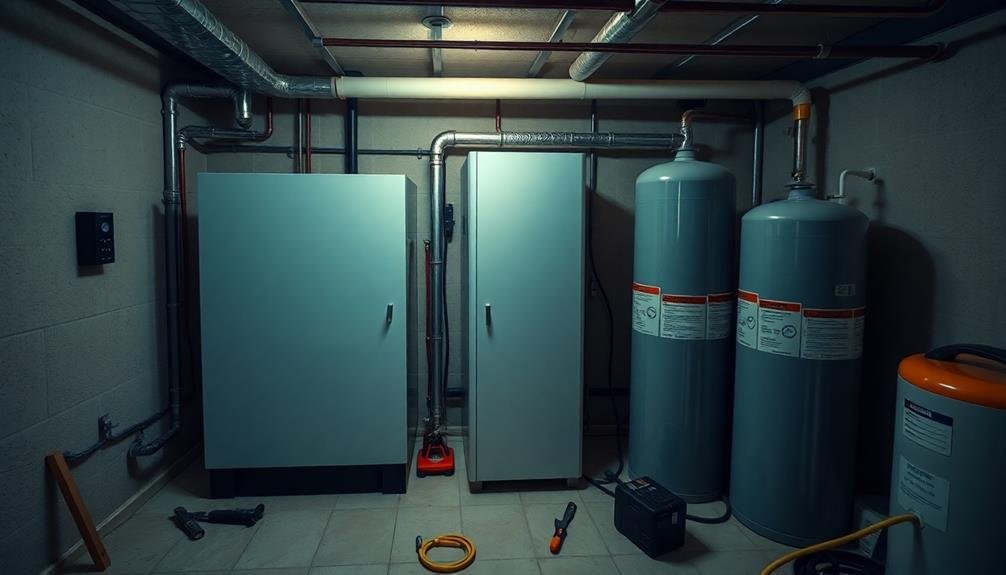
Selecting the right fuel source and storage solution is vital for your home fuel cell system. Most residential fuel cells run on natural gas or propane, with hydrogen being a less common option. If you're connected to a natural gas line, that's often the most convenient choice. For propane, you'll need to install a storage tank on your property.
When choosing your fuel source, consider:
- Availability in your area
- Cost and price stability
- Environmental impact
- Storage requirements
For natural gas, you'll simply need a connection to your existing line. Propane requires a dedicated tank, which you can either buy or rent from a supplier. Make certain you have enough space for the tank and comply with local regulations regarding placement and safety measures.
If you opt for hydrogen, storage becomes more complex. You'll need a specialized high-pressure tank and may face stricter regulations. However, hydrogen offers the cleanest operation, producing only water as a byproduct.
Regardless of your fuel choice, prioritize safety. Install appropriate leak detectors, guarantee proper ventilation, and follow all manufacturer guidelines for fuel handling and storage.
Regular maintenance of your fuel storage system is vital for the longevity and safety of your fuel cell heating setup.
Electrical Wiring and Integration
With your fuel source selected and storage set up, it's time to tackle the electrical wiring and integration of your home fuel cell system. You'll need to connect the fuel cell to your home's electrical panel and install a transfer switch. This switch allows you to seamlessly shift between grid power and your fuel cell system.
First, determine the fuel cell's output voltage and amperage. Install appropriate gauge wiring from the fuel cell to the transfer switch, ensuring it can handle the maximum current. Mount the transfer switch near your main electrical panel and connect it to both the fuel cell and the panel.
Next, install an inverter to convert the fuel cell's DC output to AC power compatible with your home's electrical system. Place this close to the fuel cell and transfer switch, minimizing wire runs. Connect the inverter to the transfer switch using properly sized cables.
Don't forget to install a battery bank for energy storage. Wire this between the fuel cell and inverter, allowing excess power to be stored for later use.
System Testing and Startup
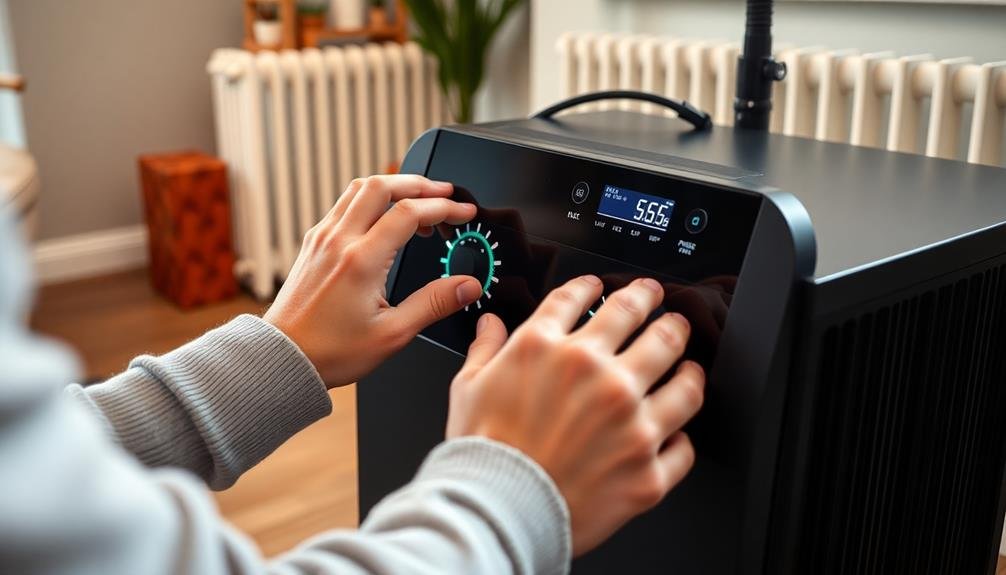
After completing the electrical connections, it's crucial to thoroughly test your home fuel cell system before startup.
Begin by checking all connections for tightness and proper insulation. Inspect the fuel supply lines for leaks using a leak detection solution. Verify that all safety systems, including emergency shutoffs and alarms, are functioning correctly.
Next, perform a dry run of the system without fuel. Power on the control unit and observe its operation. Confirm all sensors are reporting accurate readings and that the user interface is responsive.
Once you're confident in the system's electrical integrity, it's time to introduce fuel and initiate startup.
During the startup process, monitor these key parameters closely:
- Fuel cell stack temperature
- Electrical output (voltage and current)
- Fuel flow rate
- Exhaust composition
Gradually increase the system's load while keeping a close eye on performance metrics. Listen for any unusual noises or vibrations.
If you encounter any issues, shut down the system immediately and troubleshoot before proceeding.
Once your fuel cell is running smoothly at full capacity, conduct a final safety check and document all startup procedures for future reference.
Maintenance and Troubleshooting Tips
To keep your home fuel cell heating system running smoothly, you'll need to implement regular cleaning procedures and be prepared to address common issues.
You can optimize performance by following manufacturer-recommended maintenance schedules and learning to recognize early signs of potential problems.
Regular Cleaning Procedures
Regular cleaning procedures are vital for maintaining the efficiency and longevity of your home fuel cell heating system.
You'll need to perform these tasks at least once a month to guarantee peak performance. Start by shutting off the system and allowing it to cool completely. Then, carefully remove the outer casing to access the internal components.
Use a soft brush or vacuum cleaner with a brush attachment to gently remove dust and debris from the fuel cell stack, heat exchanger, and air intake.
Pay special attention to the air filter, as it's essential for preventing contaminants from entering the system. Replace it if it's visibly dirty or damaged.
For a thorough cleaning, follow these steps:
- Wipe down all surfaces with a damp, lint-free cloth
- Clean the condensate drain line to prevent clogs
- Inspect and tighten any loose electrical connections
- Check for signs of corrosion or wear on pipes and fittings
After cleaning, reassemble the system and run a test cycle to verify everything's functioning correctly.
If you notice any unusual noises, smells, or performance issues, consult your user manual or contact a professional for assistance.
Common Issues Solutions
Persistence is key when troubleshooting common issues with your home fuel cell heating system. If you're experiencing reduced efficiency, first check for fuel impurities. Clean or replace filters and guarantee you're using high-quality fuel.
For unexpected shutdowns, inspect electrical connections and reset the system. If the problem persists, you may need to recalibrate the control unit.
Low heat output often stems from clogged heat exchangers. Flush the system with a descaling solution to remove mineral buildup.
If you notice unusual noises, tighten loose components and lubricate moving parts. For water leaks, check seals and gaskets, replacing them if necessary.
When the fuel cell stack degrades prematurely, monitor operating temperatures and adjust as needed. Guarantee proper ventilation to prevent overheating.
If you encounter error codes, consult your manual for specific troubleshooting steps. Keep a log of issues and solutions to identify patterns.
Performance Optimization Techniques
Optimization of your home fuel cell heating system's performance hinges on proactive maintenance and savvy troubleshooting. Regular inspections and timely interventions can greatly boost efficiency and extend your system's lifespan.
Monitor your fuel cell's voltage output and efficiency regularly, adjusting parameters as needed to maintain peak performance. Keep your system clean and free from debris, paying special attention to air intakes and exhaust ports. Replace filters according to the manufacturer's recommendations, and guarantee proper ventilation to prevent overheating.
You'll also want to check for leaks in the fuel supply lines and address any issues promptly. To maximize your fuel cell's efficiency:
- Maintain consistent fuel quality
- Balance the electrical load to avoid overworking the system
- Implement a heat recovery system to utilize waste heat
- Use smart controls to enhance operation based on demand
Familiarize yourself with your system's diagnostic tools and error codes. This knowledge will help you quickly identify and resolve issues, minimizing downtime.
If you encounter persistent problems or notice a considerable drop in performance, don't hesitate to consult a professional technician. Regular maintenance checks by an expert can catch potential issues before they escalate, guaranteeing your fuel cell heating system operates at peak efficiency year-round.
Cost Analysis and Payback Period
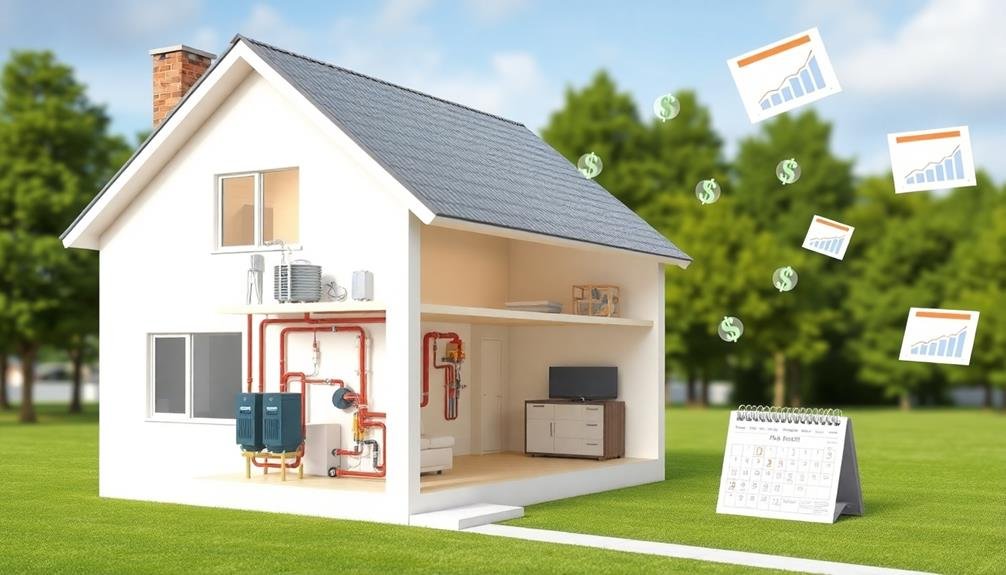
Three key factors determine the cost-effectiveness of a home fuel cell heating system: initial investment, ongoing operational expenses, and potential energy savings. Your initial investment typically ranges from $15,000 to $25,000, depending on the system's capacity and brand. Operational expenses include fuel costs, maintenance, and occasional part replacements. Energy savings stem from the system's high efficiency and potential for selling excess electricity back to the grid.
To calculate your payback period, you'll need to compare your current energy costs with projected costs after installing the fuel cell system. Here's a simplified breakdown:
| Year | Annual Savings | Cumulative Savings | Remaining Cost |
|---|---|---|---|
| 0 | $0 | $0 | $20,000 |
| 1 | $1,500 | $1,500 | $18,500 |
| 2 | $1,500 | $3,000 | $17,000 |
| 3 | $1,500 | $4,500 | $15,500 |
| 4 | $1,500 | $6,000 | $14,000 |
In this example, assuming a $20,000 initial investment and $1,500 annual savings, you'd recoup your costs in about 13.3 years. However, factors like energy prices, government incentives, and system efficiency can greatly impact your actual payback period.
Frequently Asked Questions
How Noisy Are Home Fuel Cell Systems During Operation?
You'll find home fuel cell systems are surprisingly quiet during operation. They typically produce a low hum, similar to a refrigerator. You won't hear much noise, as they're designed to run smoothly and unobtrusively in residential settings.
Can Fuel Cells Be Installed in Multi-Unit Buildings or Apartments?
You can install fuel cells in multi-unit buildings and apartments, but you'll need to evaluate space requirements, ventilation, and local regulations. It's best to consult with building management and a professional installer before proceeding.
Are There Any Odors Associated With Fuel Cell Operation?
You won't notice any odors from fuel cell operation. They're clean and efficient, producing only water vapor and heat as byproducts. There's no combustion, so you don't have to worry about smells typically associated with burning fuels.
How Does Extreme Weather Affect the Performance of Home Fuel Cells?
Extreme weather can impact your home fuel cell's performance. You'll see reduced efficiency in very cold temperatures. Hot weather may cause overheating. Heavy rain or snow could affect air intake. It's best to protect your system from harsh elements.
Can Excess Energy Produced by Fuel Cells Be Sold Back to Utilities?
Yes, you can often sell excess energy from your fuel cells back to utilities through net metering programs. You'll need to check with your local utility company for specific policies and rates in your area.
In Summary
You've now got the knowledge to install your own home fuel cell heating system. By following this guide, you'll be able to reduce your energy costs and carbon footprint while increasing your home's energy independence. Remember to prioritize safety, follow local regulations, and consult professionals when needed. With proper maintenance, your fuel cell system will provide efficient, clean energy for years to come. Embrace this cutting-edge technology and enjoy the benefits of sustainable home heating.

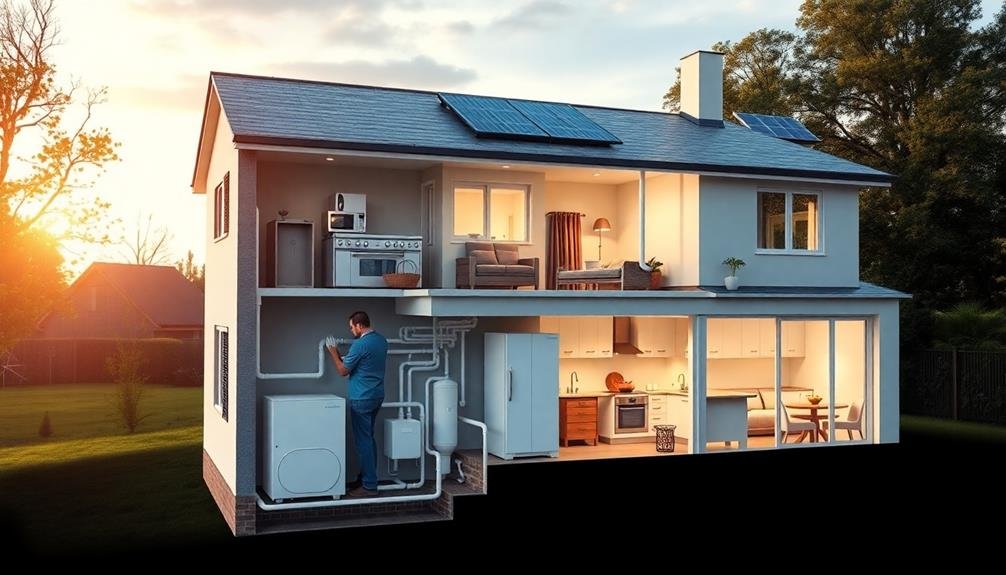



Leave a Reply